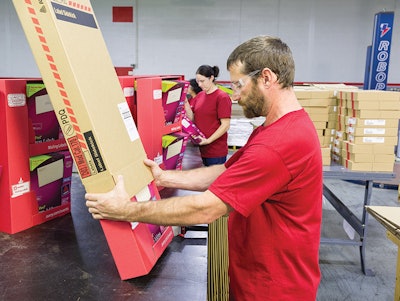Of the many decisions contract packaging suppliers, or co-packers, must make, one of the most important in the lifecycle of a contract is the ongoing and repeated purchase of packaging materials—from labels, films, containers and closures to corrugated cases and displays. There are a few primary arrangements the customer—that is, the co-packer’s customer, such as a brand owner or manufacturer—can manage with their co-packers:
1. The customer purchases the materials and provides it along with the product to be packaged by the supplier (co-packer).
2. The customer tells the co-packer what material to buy and where to buy it, and the co-packer buys it.
3. The customer provides specifications for the packaging material, and the co-packer is responsible for sourcing and purchasing to those specifications.
Which is right for you?
As usual in this service-oriented business, the answer is “it depends.” Co-packers and material suppliers agree on the need for tightly controlled specifications, and tightly managed partner communication, to get the job done.
First Choice Packaging, Fremont, OH, works in all three ways with its customers. The company is both a co-packer and a packaging material supplier; it offers turnkey contract packaging services including thermoforming, and is also exclusive North American provider of Virtuweld Packaging Technology, which produces packages that look machine-welded but are closed by hand. The processes developed on both sides of the company have reinforced a process-oriented approach to coordinating the flow of materials to the packaging line.
”A very large portion of our work is done up front,” says Frank Wolfinger, president and chief operating officer. “We work closely with our customers in the design and planning stages with the objective to not only offer the right packaging solution, but also have a smooth transition into co-pack production with accurate bills of material and work instructions to avoid surprises when timing is critical.” This includes detailed assumptions and preliminary estimates to customers “very early in a project, and if multiple designs are being considered, the customer knows how choosing one or the other design will affect their ultimate co-pack pricing.”
From the perspective of the material supplier, it makes no difference who is specifying the material and who receives it, because ultimately the job at hand is done in service of the brand owner.
“We’re involved in all three types of arrangements,” says Bill Faster, vice president of sales for Laminations, a div of Great Northern Corp., Appleton, WI. He says when the brand outsources co-packing, dealing directly with co-packers “is where the action is…they’re on the front lines. They know the details, down to the specifics of the materials being packed, and the closer we can get to the actual construction of the package, the POP display or whatever is being packed, the better we can serve the product for all involved.”
The company supplies laminated paperboard products including corner and edge protection solutions to safeguard cases and pallets, often involving printing. These are “essentially considered an expense item,” Faster says, and it’s important to optimize, for instance, the gauges of corrugated used for edge protectors. And while tweaking the gauge to save money, it’s important for the supplier to keep up-to-date records of specifications against which to perform testing based on ISTA standards—no matter whether his company is dealing with the co-packer or the brand.
The challenge for all three parties—brand, co-packer and packaging material supplier—is to prevent communication gaps, so that one party doesn’t make false assumptions as to what cost-shaving measures are acceptable. For example, a brand may have an existing co-packer but open-up bidding to additional co-packers. In such cases, it’s critical to make sure all parties are apprised of all specifications because a new co-packer that comes in with a lower price may be doing so without full knowledge of requirements.
Therefore, in addition to ensuring full specifications are included in requests for bids, Faster advises brands to “be careful not to discount the experience and knowledge that a current co-pack partner has gained over time. A new co-pack supplier might appear to save the brand money, but they need to understand all of the requirements of the total package so they don’t sub-optimize performance.” The reason is obvious: Short-term savings can result in damage in transit and cost more in the long term.
No matter who “owns” the packaging function—co-packer or the brand’s in-house facility—Chuck Miller, director of business development for Do-It Corp., South Haven, MI, supplier of hang-tabs and related retail package display components, says it’s important for packaging material suppliers to be proactive in keeping up-to-date with the brand’s package specifications. He says there have been cases where people have called to order supplies for a similar hang-tab to the one in the specs, but with a different material (such as HDPE vs. polypropylene). In cases where Do-It’s records show a different material, Miller says, “we let them know that their brand has used XYZ specification, and we strongly recommend they check with the brand before placing the order.”
Of course, specifications can change to provide improved quality, performance, protection, graphic capability or cost benefits. When there are options, brand, co-packer and material supplier must work together. In cases where a co-packer seeks to modify packaging, the process is often a “multilayer situation where everybody is involved, and signs off,” Miller says, including product designers, brand manager, co-packer and packaging material supplier. “And in cases where we’re dealing with a major brand selling to a leading retailer such as Walmart,” he adds, “they, too, might have to sign off,” to ensure compliance to their own specifications that may include additional sustainability, food safety or other requirements.
Which of the three scenarios is best?
In light of the fact that there is no one way to manage purchasing, let’s review the three ways you can work with your customers:
• First: The customer purchases the materials and provides it along with the product to be packaged by the supplier (co-packer). This is a relatively straightforward arrangement but if materials must be shipped to the brand’s facility and coordinated with shipments of products to be packaged, it can be the source of unnecessary steps in terms of transportation and supply chain steps and costs. Alternately, the customer can instruct the supplier to ship materials directly to the co-packer. In either case, the co-packer is limited to an indirect role in working with the material supplier.
• Second: The customer tells the co-packer what and where to buy the material, and the co-packer buys it. This method affords the co-packer greater, more direct control, but the brand is still managing aspects of the purchasing function that may be better served by the co-packer. The co-packer is still not a direct customer of the material supplier, and this indirect relationship may compromise the co-packer’s sense of ownership and the ability to innovate with new and potentially cost-saving innovations. For instance, if the material supplier is facing a capacity crunch, the co-packer may be in a weak position in defending its brand’s production schedules.
Lisa Shambro, executive director of F4SS, the Foundation for Strategic Sourcing, poses the question: “When it comes down to making difficult choices on who gets higher priority, it comes down to the packaging supplier having to ask: ‘Should we serve the company that is our direct customer, or our indirect customer?’”
In the first two scenarios, where the customer controls more of the purchasing function, if and when mistakes occur in ordering, scheduling and shipments of supplies—it happens—production stoppages can cause ripple effects in the schedule, labor costs and the co-packer’s overall ability to serve the brand. Shambro therefore favors this third scenario:
• Third: The customer provides specifications for the packaging material, and the co-packer is responsible for sourcing and purchasing to those specifications. In this third scenario, the co-packer can more directly ensure that the customer’s needs are being met. Additionally, the co-packer may be further empowered to consider new or innovative packaging material alternatives, negotiate better pricing or consider a change in suppliers if there are benefits to be gained.
In other words, the material supplier is “their customer, and they’re in control of their own destiny,” explains Shambro. In terms of negotiating contracts, she says, “the latest trend we’re seeing in terms of best practices is the application of SRM and supplier management,” which she discussed in her March/April Cost Cutter column in Contract Packaging magazine; and SRM-consistent key performance indicators, the subject of her July/August column in the magazine.
This story is adapted from and appears courtesy of the CPA Connection E-Newsletter.


























